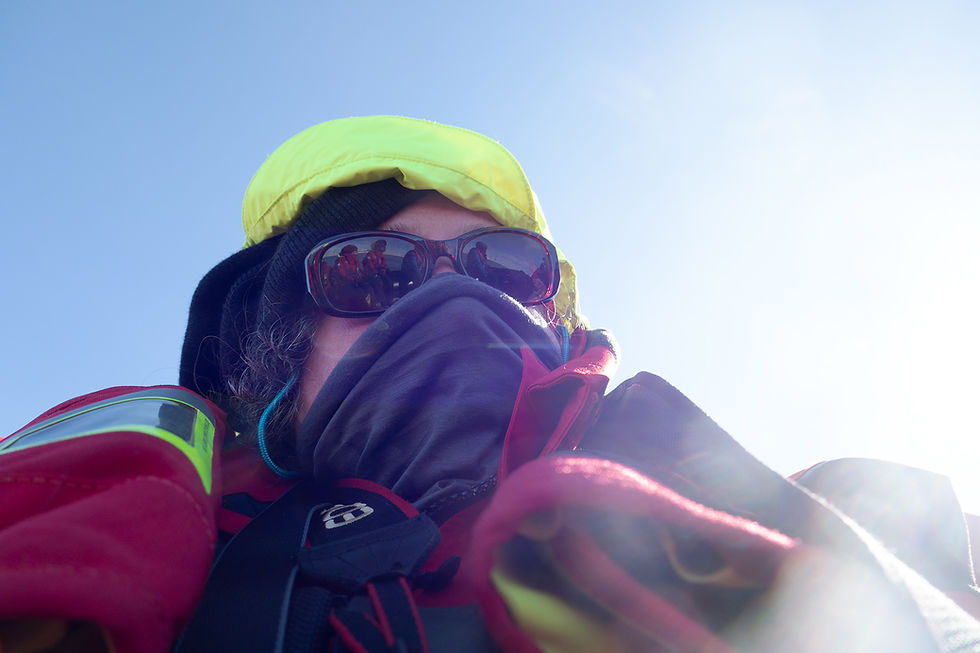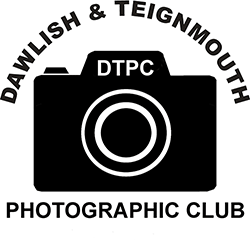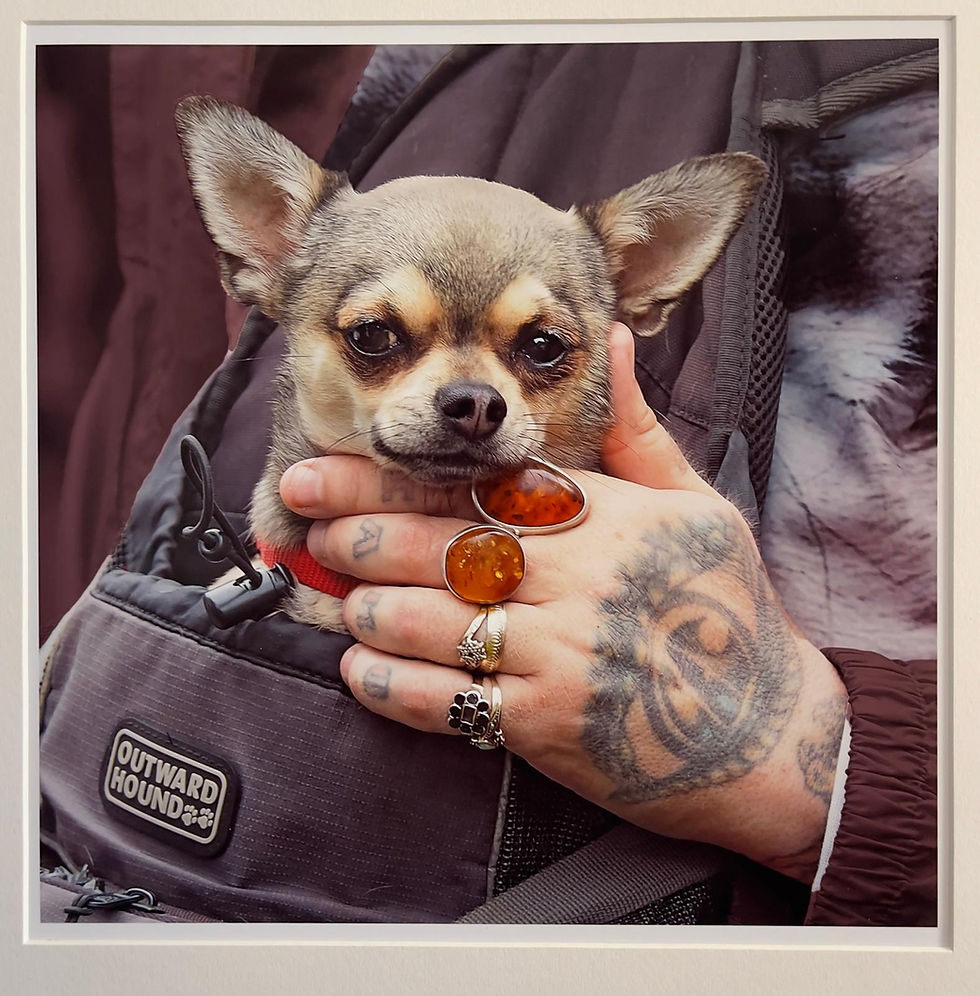The Land of the Midnight Sun
- Naomi Stolow

- Aug 25, 2018
- 9 min read

Arctic tern
I was up in Svalbard in July. I was on a ship for 2 weeks of 24/7 daylight and 24/7 photography. It was wonderful, necessary, refreshing, inspiring and just what the doctor ordered - nature’s prozac at it’s best.

Due to work commitments, expensive renovations and the upheaval of leaving the London rat race behind for a better life in our beautiful village down here, I’d not been away anywhere for the last four years or so and needed to put myself into completely new, unchartered territory and to immerse myself in my photography. I was ready. I have traveled the globe fairly well and although I have been above the arctic circle twice in wintertime I have never experienced true Northern Arctic conditions in summertime. And boy did we go north.. right up to within 500 miles of the North Pole at 81.5 degrees.
In Svalbard my iPhone said sunset at 00:00 and sunrise at 00:05!

Atlantic puffin
Svalbard is a truly magical place. It is eerie, mystical, mesmerising and stunningly beautiful
Limited colours in the landscape ranged from powdery blue skies to incredible ranges of turquoises in the sea and ice and pale buffy brown mountains and white snow often topped with the most beautiful patterns of brown sand and earth.
The weather ranged from between minus 6 and plus 6, changing between sunny days with clear blue skies and mirror-like calm seas to windy, rainy days that were moody and rough.
And the light cast down by the midnight sun was so beautiful it made me weep.
It was so great just concentrating on photography without interruptions, without the internet, without the news, without attending to family duties, without thinking about DIY and renovations, without work, without anything other than me and my camera. Nothing else was important during those two weeks.

Little auks
Remoteness
Once we left Longyearben there was no phone signal, no internet, no phone, no nothing. Out there any accident would have meant the end to the trip for everyone, days of sailing to return to Longyearben and then further flights to a hospital. Not what anyone wants. It was easy to forget how far from civilisation we were.
The other-worldly 81.5 degrees north
As well as going around Spitzbergen we sailed right up much further north, to the edge of the ice cap. 500 miles further was the North Pole!
Up there it was other-worldly and hard to describe:
White fog
Fog bows
The clear defined edge of the ice cap
A blue whale
Harp seals playing at the edge of the ice
Birds
Ever changing
Utterly freezing winds
Calm sunshine
Blue skies
Loudly crinkling, crackling, ever-moving ice
Sea
Nothingness yet everything

This is the actual, clearly defined edge of the ice cap
Sailing around Svalbard, what was it like out on the zodiacs?
Getting ready was complicated!
Wrapped in our multiple layers of thermals we trotted down to the 'wet room' where we donned our outer gear - fisherman trousers from ankle to shoulders, giant wellies, thick coats and lifejackets.
It is a vision to behold - seeing us donning all the kit with legs and arms flying everywhere and puffy red faces as we struggled with reaching our feet to get the wellies done up, adjusting life jackets, sorting out our waterproof backpacks - all an exhausting task that leaves you feeling like a puffy puffed-out michelin man!
I had been down to our local garden centre before the trip to bag a pair of knee pads, and these were invaluable for kneeling at the bottom of the zodiacs and trying to get the lowest angles possible! They bulked out my already huge knees and completed my absurd yet strangely fitting "arctic look". I highly recommend knee pads for most kinds of wildlife photography!


All non-negotiablely necessary for leaving our boat in such remote and inhospitable climbs though.
Once all ready and 'signed off' by the crew we climbed down the steep gangway and into the zodiacs in small groups.

Polar bear. Blood still on its face after eating a sealion
The zodiac ride
Being out on the water at sea level is a lovely feeling and I enjoyed the arctic breeze (appreciating the effort of donning all that clobber) and we doodled about along the glacier and amongst incredible icebergs looking for wildlife.
Set within the stunning light of the Midnight Sun it became obvious that icebergs are a photographers dream. We weaved around the ancient ice, sometimes the sun in-front lighting up sophisticated patterns and sometimes, even better, from behind - shining through - revealing inner patters and complex markings designed solely by mother nature over their journeys to the sea.

Ice
I just couldn't help but photograph the ice in all it's various forms as we bobbed around, though not getting too close - I noted that each iceberg has it's own mind in bossing around the sea that sways around it creating currents and tides all of its own and how it orders the water to get sucked under it with force!





Icebergs
Wildlife
It is hard to imagine anything living in such a harsh environment, but out of the blue we saw surprises - like this bearded seal just lying there sublimely on a piece of ice. You can imagine how excited I was to see it with its glorious whiskers and nostrils and the paws. THE PAWS! And what beautiful fur. And a deep rusty red head, not because it was born that way but because it spends the day rummaging the iron rich sea bed for food.
Rules dictate the distance you can go towards any wildlife sighting and our guides kept a close eye that we didn't drift in, also looking out for any signs of distress. Thankfully this fine specimen remained relaxed in our presence!

Bearded Seal

Walrus
Calving glaciers
We would often hear the odd bang as bits of glacier calved off or collapsed inwards - it was such a loud sound that at first I thought it was gunshot! We'd all jump out of our skins and then we'd see ice powder puff out somewhere through the glacier wall - and the birds who are wise to this waiting at the edge for the resulting kerfuffles and confused fish!

Kittiwakes waiting for the ice to crumble
Photography from a zodiac?
It was challenging!
The swell made standing up impossible unless we were in an area of complete calm. We were not allowed to stand up without permission, for the risk of falling in the sea was too great. This meant focusing on anything was exhausting. The object of focus would come and go, into the frame and out again making it difficult to lock-on to anything. Then there was the problem of other peoples heads in the way. We tried to organise ourselves into -kneeling on one side and sitting on the other, but not everyone could or wanted to kneel. For example, you'd finally lock focus on that polar bear over there but someone's hat would wander over your lens at the crucial moment. That was frustrating. A small price to pay for the sights we saw with our own eyes though. The light was so bright at least I didn't have to worry about pushing the ISO.

Curious walruses
Photography on land?
For each landing the area had to be scouted out for polar bears. Even if the proposed landing site had been cleared and a bear was subsequently seen, then landing could not occur. When we did land, we had to walk in lines, with an armed guard at the front and another at the back. The guards are very well trained in bear handling and have a whole series of procedures to use before ever using their pistol or rifle. They told us that their clackers, shouting and clapping usually deter bears. If that doesn't work then they have sprays and other methods and will only use the gun as a very last resort. Thankfully the scouts had done a good job for us and we had no trouble.

Ice
The main challenge to photography on land was the amount of clothing and clobber weighing us down. The huge welly boots were cumbersome and we were limited by what we could carry. And sticking to the group was sometimes a challenge as photographers tend to wander and wandering in bear country is a no-no.
There were NO toilet stops on any excursions!

Kittiwakes
It was fascinating watching others do photography. Here’s what I observed:
People got very carried away in the excitement of a 'wildlife sighting' without grounding themselves and thinking “Is this what I want my photo to be like?”’ and “Does this image tell a story?” or even “How do I interpret this scene?” or most importantly "Am I using the right settings to get what I want?"
People only going for the cliche shots. Don’t get me wrong, there is nothing better than bagging a cliche shot. We all need them, but what after that is the interesting part for me - how we interpret and record what we see.
People zooming in too much - they forget to zoom out and show the environment.
I saw so many people furiously clicking like crazy and then being terribly disappointed when back in the photo-editing media room - it was heartbreaking to see. I know this feeling as I am often broken by my own mistakes too.
I saw people confused as they were expecting to take National Geographic quality photos - without having put in the hard graft and learning beforehand, leaving them disappointed.
I saw people clicking so furiously that they never stopped to simply watch the incredible scenes before their eyes. A few sightings were so special I wanted to drink in what I was seeing and burn it on to my mind forever.

Kittiwakes
I have been there in all these ways, so I completely get the whys for all the above. I have all those t-shirts, and still wear them - there is always so much more to learn and I know very little really. I am just a nobody who loves taking photographs of wildlife and nature. But observing all this made me aware of how much wiser I am now.

Harp Seal
People wanted to sit beside me on the zodiacs to see what I was doing. In moments of calm they were asking to see what I’d done and how I did it. For example, "How ‘did’ I capture that bird in flight?" I actually didn’t mind helping people out if I could. It felt good seeing their progress and the sheer joy of nailing a shot that they were messing up before. It also felt like a bit of a confidence boost for me.

Arctic Tern
Also, when asked ‘how’ I got a particular image I told them I photograph the garden birds for about an hour each day before work - regardless of weather, just to keep my hand in and to keep learning and discovering new ways of doing things. That's how. There are no magic settings, just settings appropriate for the scene before you versus what you want to achieve. Then I told them my settings and why I used them in that way.

Our zodiac
* * *
Getting away from what you normally do inspires new ways of thinking about things. Like that old saying of 'put some water between you and your problems'. I had many streams of thought that went like this......

Polar bear
People only really protect what they love
This Arctic area and the Antarctic are the last truly wild places on our troubled planet and we have to ensure they stay that way. And yes, we did find plastic rubbish there. We fished it out of the sea and gathered it from the beaches.
If you are told to protect something in a job-description then it becomes a mathematical exchange - and that can only ever be be short term.
For example, I feel our politicians only worry about environmental results within their duration in office - so will by nature of their jobs never embark on any really long term, meaningful goals to better the environment. I have no faith in our own government and the orange Trump ‘thing’ in the US is terrifying on any matters environmental. Each time I hear a new story about his blatant disregard for protected areas and endangered species I get more and more worried. I feel the same about leaving the EU - will our lot enforce all the protection the EU has given our wildlife?

4,000 year old glacial ice

Patterns in the hills
When we, us - the humans, go to remote places we have a responsibility to protect those places and one way we can do this is to use photography.

Waterfall

Mountainside
I know we can’t all get to places remote like Svalbard… the cost and effort is huge, however, the one thing I’ll say is, this: giving yourself the gift of immersing yourself into doing what you love is a wonderful, nourishing thing.
It is a rare and immense privilege to visit such places and I owe it to mother nature to create the best images I can.
This is what I have tried to do.

Arctic Fox with a goose egg

Arctic Reindeer

Cheers! There was Baileys in that hot chocolate!
Thank you for reading!
ps, Here's some trivia:
I learnt that there are many words to describe ice:
Brash ice - this is a collection of small ice chunks that have fallen off a 'glacier growler'
Glacier growler - I love this name - is a small piece of low lying floating ice that a glacier has 'calved' (or given birth to) as it melts. They are 1 to 5 metres in size (above sea level, who knows what lies beneath?)
Bergy bit - this is an aptly named medium sized bit of flatter ice between 5 and 15 metres.
Iceberg - this is the official word for floating ice from a glacier, and anything bigger than a Bergy Bit. As our Ocean Notes kindly pointed out, it is also a type of lettuce!




Comments